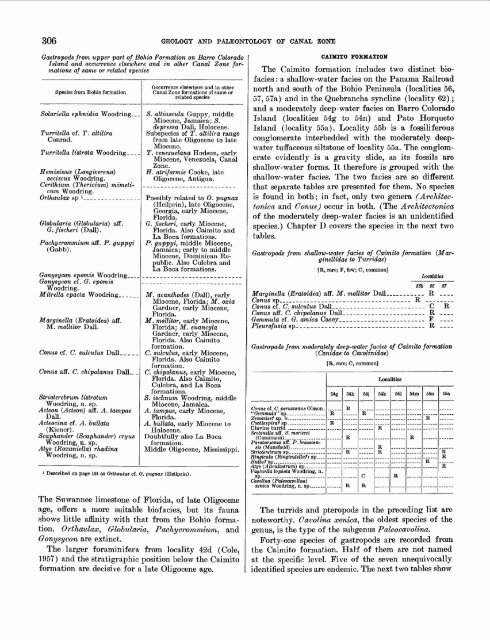Geology and Paleontology of Canal Zone and Adjoining ... - USGS
Geology and Paleontology of Canal Zone and Adjoining ... - USGS
Geology and Paleontology of Canal Zone and Adjoining ... - USGS
You also want an ePaper? Increase the reach of your titles
YUMPU automatically turns print PDFs into web optimized ePapers that Google loves.
306 GEOLOGY AND PALEONTOLOGY OF CANAL ZONE<br />
Gastropods from upper part <strong>of</strong> Bohio Formation on Barro Colorado<br />
Isl<strong>and</strong> <strong>and</strong> occurrence elsewhere <strong>and</strong> in other <strong>Canal</strong> <strong>Zone</strong> for<br />
mations <strong>of</strong> same or related species<br />
Species from Bohio formation<br />
Solariella ephnidia Woodring. __<br />
Turritella cf. T. altilira<br />
Conrad.<br />
Turritella listrota Woodring____<br />
Hemisinus (Longiverena)<br />
oeciscus Woodring.<br />
Cerithium (Thericium) mimeticum<br />
Woodring.<br />
Orthaulax sp 1 ______________.<br />
Globularia (Globularia) aff.<br />
G. fischeri (Dall).<br />
Pachycrommium aff. P. guppyi<br />
(Gabb).<br />
Gonysycon epomis Woodring.<br />
Gonysycon cf. G. epomis<br />
Woodring.<br />
Mitrella epacta Woodring. _ _<br />
Marginella (Eratoidea) aff.<br />
M. mollitor Dall.<br />
Conus cf. C. sulculus Dall____<br />
ConUs aff. C. chipolanus DalL.<br />
Strioterebrum listrotum<br />
Woodring, n. sp.<br />
Acteon (Acteon) aff. A. tampae<br />
Dall.<br />
Acteocina cf. A. bullata<br />
(Kiener).<br />
Scaph<strong>and</strong>er (Scaph<strong>and</strong>er) cryus<br />
Woodring, n. sp.<br />
Atys (Roxaniella) rhadina<br />
Woodring, n. sp.<br />
1 Described on page 191 as Orthaulax cf. 0. pugnax (Heilprin).<br />
Occurrence elsewhere <strong>and</strong> in other<br />
<strong>Canal</strong> <strong>Zone</strong> formations <strong>of</strong> same or<br />
related species<br />
S. altiuscula Guppy, middle<br />
Miocene, Jamaica; S.<br />
depressa Dali, Holocene.<br />
Subspecies <strong>of</strong> T. altilira range<br />
from late Oligocene to late<br />
Miocene.<br />
T. venezuelana Hodson, early<br />
Miocene, Venezuela, <strong>Canal</strong><br />
<strong>Zone</strong>.<br />
H. atriformis Cooke, late<br />
Oligocene, Antigua.<br />
Possibly related to 0. pugnax<br />
(Heilprin), late Oligocene,<br />
Georgia, early Miocene,<br />
Florida.<br />
G. fischeri, early Miocene,<br />
Florida. Also Caimito <strong>and</strong><br />
La Boca formations.<br />
P. guppyi, middle Miocene,<br />
Jamaica; early to middle<br />
Miocene, Dominican Re<br />
public. Also Culebra <strong>and</strong><br />
La Boca formations.<br />
M. acanthodes (Dall), early<br />
Miocene, Florida; M. oxia<br />
Gardner, early Miocene,<br />
Florida.<br />
M. mollitor, early Miocene,<br />
Florida; M. euancyla<br />
Gardner, early Miocene,<br />
Florida. Also Caimito<br />
formation.<br />
C. sulculus, early Miocene,<br />
Florida. Also Caimito<br />
formation.<br />
C. chipolanus, early Miocene,<br />
Florida. Also Caimito,<br />
Culebra, <strong>and</strong> La Boca<br />
formations.<br />
S. ischnum Woodring, middle<br />
Miocene, Jamaica.<br />
A. tampae, early Miocene,<br />
Florida.<br />
A. bullata, early Miocene to<br />
Holocene.<br />
Doubtfully also La Boca<br />
formation.<br />
Middle Oligocene, Mississippi.<br />
The Suwannee limestone <strong>of</strong> Florida, <strong>of</strong> late Oligocene<br />
age, <strong>of</strong>fers a more suitable bi<strong>of</strong>acies, but its fauna<br />
shows little affinity with that from the Bohio forma<br />
tion. Orthaulax, Globularia, Pachycrommium, <strong>and</strong><br />
Gonysycon are extinct.<br />
The larger foraminifera from locality 42d (Cole,<br />
1957) <strong>and</strong> the stratigraphic position below the Caimito<br />
formation are decisive for a late Oligocene age.<br />
CAIMITO FORMATION<br />
The Caimito formation includes two distinct bio<br />
facies : a shallow-water facies on the Panama Railroad<br />
north <strong>and</strong> south <strong>of</strong> the Bohio Peninsula (localities 56,<br />
57, 57a) <strong>and</strong> in the Quebrancha syncline (locality 62);<br />
<strong>and</strong> a moderately deep-water facies on Barro Colorado<br />
Isl<strong>and</strong> (localities 54g to 54n) <strong>and</strong> Pato Horqueto<br />
Isl<strong>and</strong> (locality 55a). Locality 55b is a fossiliferous<br />
conglomerate interbedded with the moderately deep-<br />
water tuffaceous siltstone <strong>of</strong> locality 55a. The conglom<br />
erate evidently is a gravity slide, as its fossils are<br />
shallow-water forms. It therefore is grouped with' the<br />
shallow-water facies. The two facies are so different<br />
that separate tables are presented for them. No species<br />
is found in both; in fact, only two genera (Architec-<br />
tonica <strong>and</strong> Conus) occur in both. (The Architectonica<br />
<strong>of</strong> the moderately deep-water facies is an unidentified<br />
species.) Chapter D covers the species in the next two<br />
tables.<br />
Gastropods from shallow-water facies <strong>of</strong> Caimito formation (Mar-<br />
ginellidae to Turridae)<br />
[R, rare; F, few; C, common]<br />
Localities<br />
55b 56 57<br />
Marginella (Eratoidea) aff. M. mollitor DalL __________ R ___.<br />
Conus sp___________________________________ R _______<br />
Conus cf. C. sulculus Dall_______-_-_-___--______--- C R<br />
Conus aff. C. chipolanus DalL ______________________ R ___.<br />
Gemmula cf. G. arnica Casey________________________ F ___.<br />
Pleur<strong>of</strong>usia sp------------------------------------ R -__.<br />
Gastropods from moderately deep-water facies <strong>of</strong> Caimito formation<br />
(Conidae to Cavolinidae)<br />
Conus cf. C.peruvianus Olsson.<br />
Srobinella aff. S. morierei<br />
Paraborsonia aff. P. brassoen-<br />
Vaginella lophota Woodring, n.<br />
Cavolina (Paleocavolina)<br />
[R, rare; C, common]<br />
54g<br />
R<br />
R<br />
54h<br />
R<br />
R<br />
R<br />
R<br />
54j<br />
R<br />
C<br />
R<br />
Localities<br />
The turrids <strong>and</strong> pteropods in the preceding list are<br />
noteworthy. Cavolina xenica, the oldest species <strong>of</strong> the<br />
genus, is the type <strong>of</strong> the subgenus Paleocavolina.<br />
Forty-one species <strong>of</strong> gastropods are recorded from<br />
the Caimito formation. Half <strong>of</strong> them are not named<br />
at the specific level. Five <strong>of</strong> the seven unequivocally<br />
identified species are endemic. The next two tables show<br />
54k<br />
R<br />
R<br />
R<br />
541<br />
R<br />
54m<br />
R<br />
54n<br />
R<br />
R<br />
55a<br />
R<br />
R<br />
R

















